Most people associate broccoli with the classic giant greenheads found at grocery shops or a nearby farmer’s marketplace. But there is a whole plant of which you may be unaware, which is broccoli microgreens.
What precisely are they? Are they distinct from normal broccoli? What exactly are the advantages of broccoli microgreens nutrition? And how could you put them to good use? Let us explore!
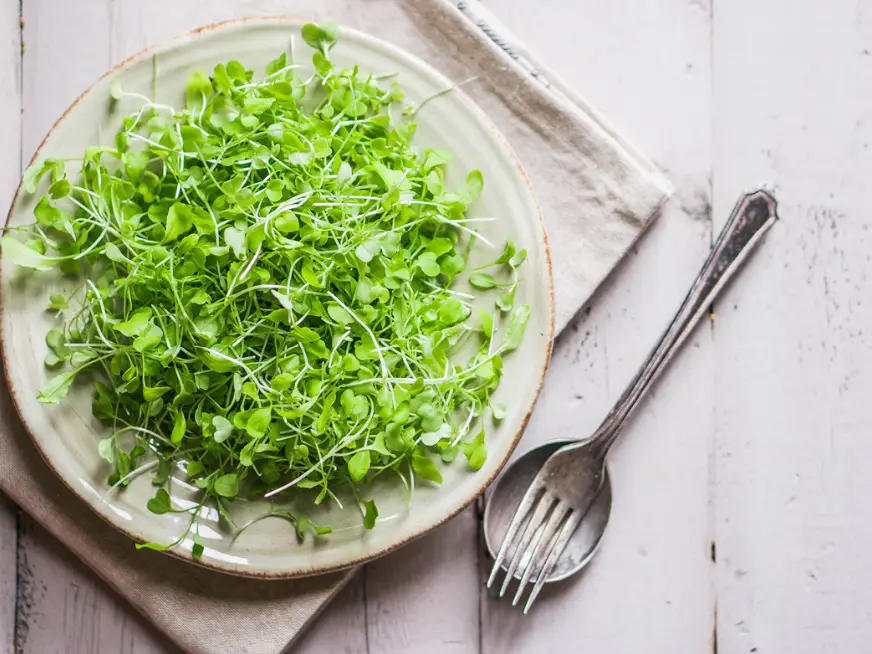
Contents
- 1 What are broccoli microgreens?
- 2 Are broccoli microgreens good for you?
- 3 Nutritional and health benefits of eating broccoli microgreens
- 4 Are broccoli microgreens healthier than broccoli?
- 5 How can you grow broccoli microgreens at home?
- 6 The harvesting procedure
- 7 Can you eat too many broccoli microgreens?
- 8 FAQs
- 9 Conclusion
What are broccoli microgreens?
To avoid confusion with broccoli sprouts, broccoli microgreens are young, tender plants that are grown from the seeds of broccoli. They are harvested when they are just a few inches tall and have developed their first set of leaves.
Broccoli sprouts, on the other hand, are sprouted broccoli seeds. They possess tiny little leaves and white stems. They are young broccoli florets that are approximately three to four days old.
They have the appearance of alfalfa sprouts, a flavor reminiscent of radishes, higher carbohydrates than broccoli microgreens, and a comparable nutritional profile.
They must be carefully washed since they stand a greater probability of transmitting E. coli because they develop best in damp surroundings.
If you want to maintain optimal health, incorporating broccoli microgreens into your diet is absolutely crucial. These microgreens are loaded with essential nutrients, including Vitamin K, potassium, magnesium, and iron, which offer a wide range of benefits.
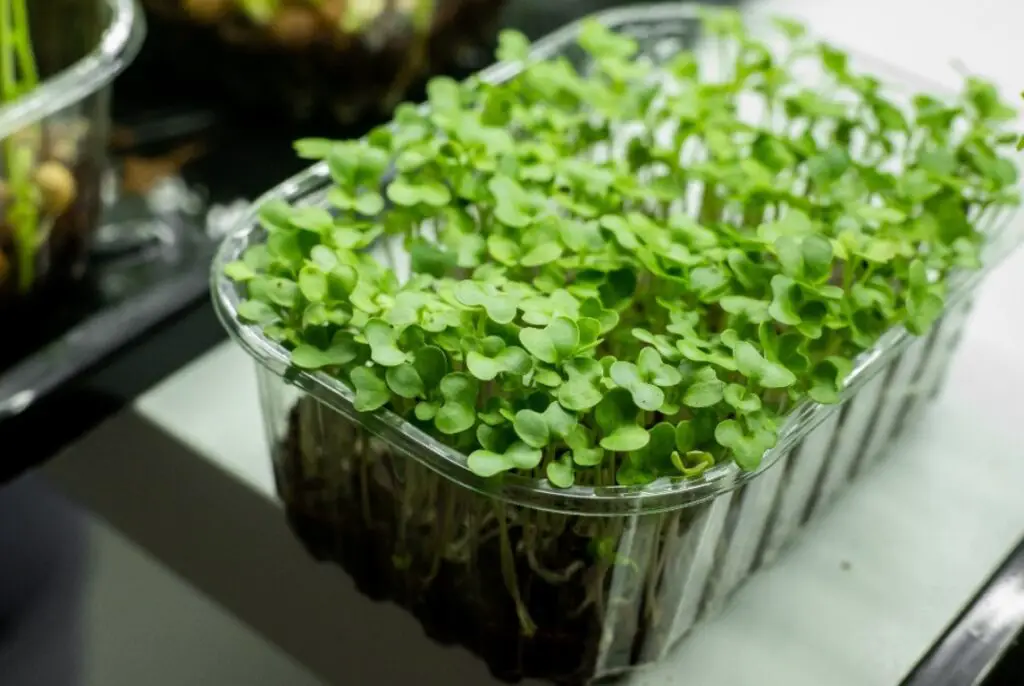
For the best results, it’s important to consume broccoli microgreens regularly.
They also contain a lot of sulforaphane, a phytochemical. This vitamin may additionally be found in cruciferous plants like cabbage and cauliflower and Brussels sprouts.
Sulforaphane appears to be beneficial in the prevention and treatment of chronic diseases, including numerous types of cancer. Sulforaphane can improve your digestive health by fighting inflammation and cancer cells and increasing your immune system.
They have a mild, slightly sweet flavor and are often used in salads, sandwiches, and as a garnish for various dishes. They are also popular among health-conscious individuals due to their high nutritional value.
Are broccoli microgreens good for you?
Indeed, broccoli microgreens are really beneficial to your health. The nutritional of broccoli microgreens are packed with nutrients, enzymes, and antioxidants, which can assist enhance physical functioning and well-being.

According to certain research, broccoli microgreens may have anti-inflammatory and anti-cancer qualities.
Therefore, integrating them into your diet can be an excellent method to increase your nutritional intake while also supporting optimal health benefits.
Nutritional and health benefits of eating broccoli microgreens
Below are the benefits of broccoli microgreens.
Broccoli microgreens are mood boosters
What are the main broccoli microgreens benefits for your health? Because of their high quantities of vitamin C and folic acid, broccoli microgreens may help boost general mood.
Broccoli microgreens are a highly interesting topic, and this article delves into their numerous benefits. They are particularly effective at boosting one’s mood, thanks to their high levels of vitamin C and folic acid.
Furthermore, research has shown that incorporating more fruits and vegetables into one’s diet can reduce stress levels.
Serotonin is regarded as the “feel-good” hormone because it induces emotions of satisfaction and happiness. It may further enhance visual cognition, learning, memory, and aggression control.
L-tryptophan is essential for boosting serotonin levels, which promotes happiness and cognitive function. Broccoli is a good source of L-tryptophan. Aids in the fight against cancer
Did you know that broccoli microgreens contain vitamin C and glucosinolates? These compounds break down into several powerful chemicals, with sulforaphane being the most active. Research has shown that sulforaphane can help fight cancer by promoting cell death and inhibiting tumor growth.
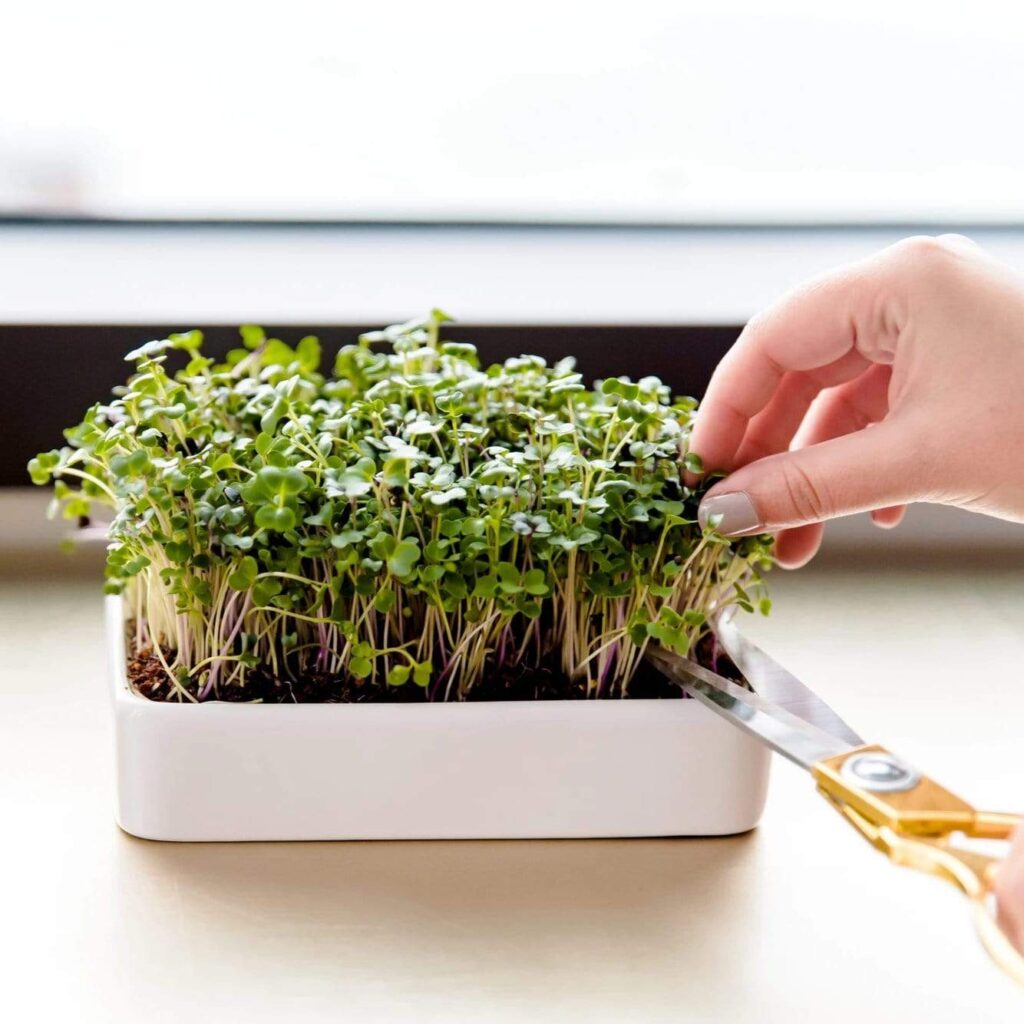
Additionally, studies have demonstrated that sulforaphane can even reverse or reduce the damage caused by cancer-causing chemicals.
Research has shown that sulforaphane can effectively suppress breast cancer stem cells and is a valuable treatment option for multiple types of cancer, such as prostate cancer, oral cancer, skin cancer, colon cancer, and bladder cancer.
Regularly eating broccoli microgreens can assist in battling these serious diseases.
Lowering the risk of heart disease
Broccoli microgreens, among other cruciferous vegetables, are high in sulforaphane, a sulfur-rich chemical with numerous health advantages, particularly in supporting cardiovascular wellness and combating cardiovascular disease.
Sulforaphane has anti-inflammatory properties that are useful in combating inflammation and the elimination of free radicals that can lead to a state of oxidative stress.
Furthermore, broccoli microgreens contain nitrates, that are then broken down to produce nitric oxide. Nitric oxide helps to dilate and calm blood vessels, which results in a more efficient circulatory system.
This aids in blood pressure regulation, hence enhancing cardiovascular health like other cruciferous vegetables.
Nitric oxide suppresses the production of cholesterol inside the vessel walls as well as clots in the blood, which can lead to cardiac events and strokes.

Helps to ease digestion
The large amount of fiber in broccoli microgreens improves digestion by boosting stability and reducing constipation.
The elevated quantities of insoluble fiber assist in cleaning out the gastrointestinal tract by cleaning through it and gathering undesired things such as pollutants and undigested meals.
Studies demonstrate that broccoli microgreens increase gastric juice and the production of bile, enabling digestion better.
Broccoli microgreens can help defend against diseases including E. coli, salmonella, and shigella.
Improves vision
It’s crucial to prioritize our eye health, especially for those who are dealing with age-related macular degeneration (AMD). Incorporating lutein into our routine can offer numerous benefits for maintaining optimal eye health.
AMD causes vision loss by destroying portions of the retina; lutein can prevent AMD impairment by assisting to defend against oxidative stress as well as inflammation.
Consuming foods rich in zeaxanthin may prevent the development of cataracts along with age-related macular degeneration (AMD).
Besides contributing to eye health, zeaxanthin may help fight cancer and coronary artery disease.
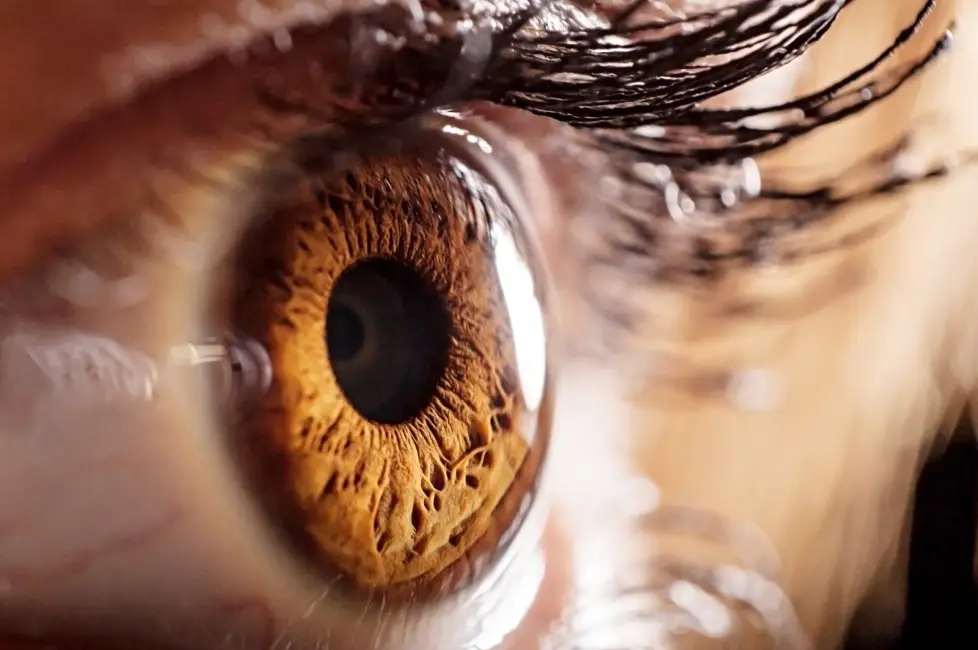
Boosts immune system
Consuming broccoli microgreens helps strengthen your immune system since broccoli is high in glucoraphanin, a substance with significant antioxidant and anti-inflammatory qualities.
The microgreens are likewise high in vitamins A, C, and vitamin E, which all constitute potent antioxidants that combat free radicals and aid in preventing disease.
Vitamin C, for example, has been proven to strengthen the immune system by combating bacteria and viruses, particularly in the winter months.
Therefore, consume broccoli microgreens regularly to ward off illnesses such as colds and flu! In case you don’t receive sufficient amounts of vitamin C in your daily meals or are interested in improving your immune system.
Furthermore, broccoli microgreens contain a substantial quantity of folic acid, which has been scientifically demonstrated to stimulate the immune system as well as preserve normal blood pressure.
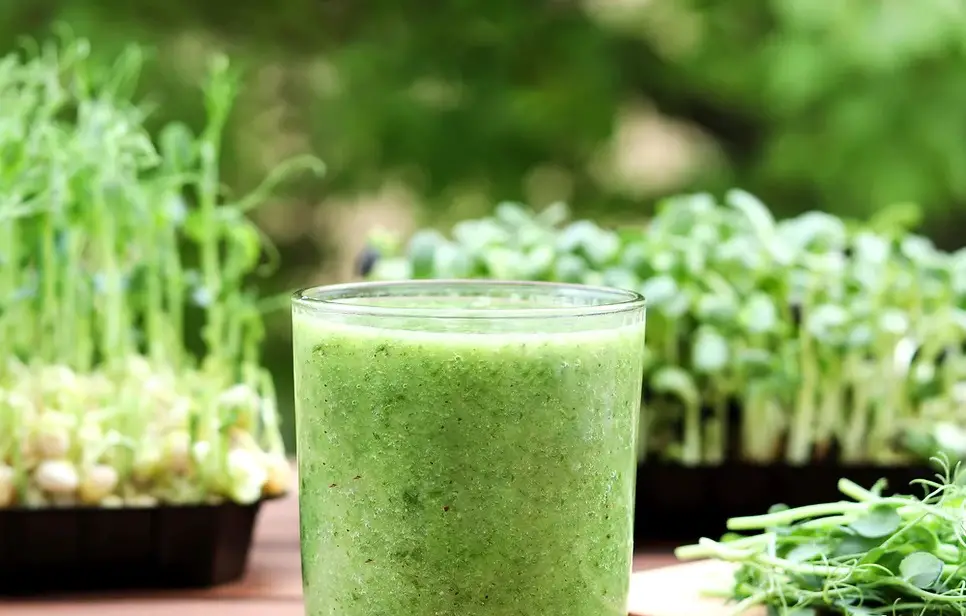
Helps to fight fatigue
They are an excellent source of energy. These foods are high in B vitamins, iron, potassium, calcium, and magnesium, among other beneficial nutrients.
Iron deficiency can induce weariness and anemia, which could be avoided by eating broccoli microgreens regularly.
Additionally, these vegetables have a high chlorophyll content, which assists in cleansing your body of impurities and boosts your metabolism.
Furthermore, broccoli microgreens provide twice the protein content of typical cooked leafy greens. This vital component is particularly advantageous for folks who regularly exercise and require extra protein in their dietary intake.
In addition, it slows digestion, leaving you staying fuller for longer while maintaining your energy levels stable. Therefore, in case you haven’t already, begin to consume broccoli microgreens now!

Are broccoli microgreens healthier than broccoli?
They are more concentrated in nutrients than mature broccoli, but they are not necessarily healthier. While broccoli microgreens contain higher levels of vitamins and minerals, they also have a higher concentration of certain compounds that can be harmful in large amounts, such as glucosinolates.
Additionally, they are typically consumed in smaller quantities than mature broccoli, so the overall health benefits of broccoli may not be significant.
It is important to include a variety of fruits and vegetables in your diet to ensure you are getting a wide range of nutrients.
Broccoli microgreens provide adequate quantities of vitamin C, a greater quantity of vitamin E over adult broccoli plants, but lower levels of vitamin K, which renders them ideal for people with compromised kidney function.
According to research studies, they contain up to ten times the amount of sulforaphane as mature broccoli plant.
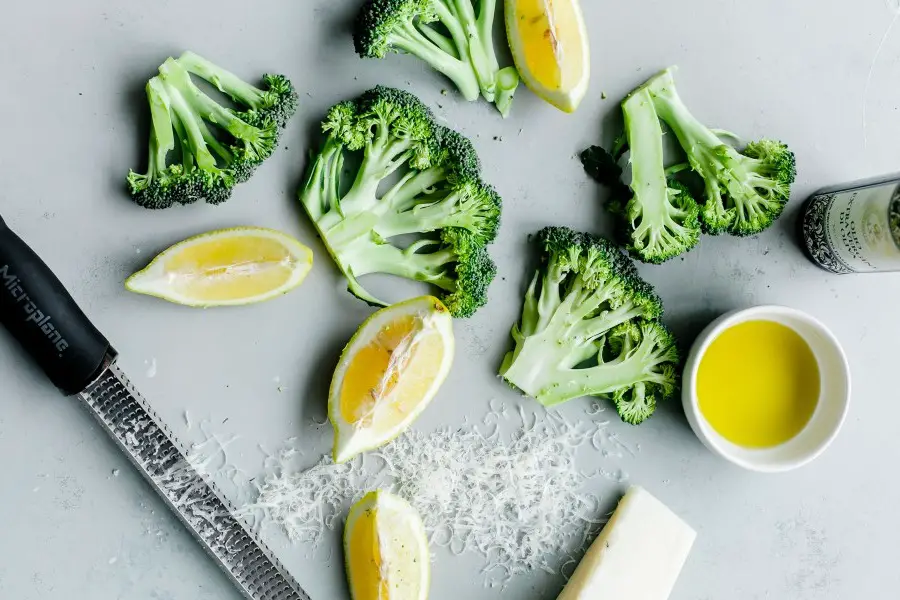
How can you grow broccoli microgreens at home?
Growing broccoli microgreens is easy and requires only a few simple items such as seeds, basic supplies, water, and ample sunlight. Even if you have limited space, it’s possible to grow your own broccoli microgreens on a sunny windowsill.
Materials needed to grow broccoli microgreens
- Good quality seeds of broccoli.
- A deep container or planting pan with holes for drainage to remove excess water.
- Two more trays with no drainage holes.
- The soil or planting mixture.
- Having a sufficient amount of light is crucial to grow microgreens, as it is required for the photosynthesis process that enables them to turn green. While natural sunlight can be used, it may be more convenient to opt for a grow light, as this provides complete management over the level of light the plants receive.
Make the soil ready
In an average-sized pot or planter pan with drainage openings, combine a mix of peat moss and organically grown compost. Natural soil blends are available pre-prepared or you can build your mixture by combining multiple parts of organic matter, two portions of peat moss, along with a single part of sand or perlite as well.
Load the container or tray with soil to a depth of approximately an inch over the rim, then lay it down on a tray with no draining holes to gather any leaking water that comes from the top.
Plant the seeds
You’re going to need about 100 broccoli seeds per square meter of soil where you intend to grow broccoli microgreens. Sprinkle the seeds uniformly onto the soil, and lightly tap.
To achieve the best results, it’s essential to ensure that the soil is thoroughly covered. Additionally, it’s important to keep in mind that microgreens require minimal space.
Set the rest of the tray over top as a guide. Cover the seeds for two or three days.
When you observe the little leaves sprouting from the soil, uncover the lid. If you see a white fiber emerging out from the dirt, you’re not seeing mold; that is the root hair.

Position your tray in direct sunlight
Sunlight is necessary for plant development and aids in several important processes, including the production of chlorophyll and its use as nutrition. The majority of plants need no less than six hours of direct sunlight each day.
To ensure the best possible growth, it’s crucial to place the tray in an area that gets at least six hours of direct sunlight every day. A sunny veranda is a great option as well.
Avoid exposing your broccoli microgreens to extreme radiation from sources of heat such as heaters or radiators.
Fill your trays with water
Spray your tray with water first thing in the early hours of the morning or late in the night to maintain a proper humidity level within your soil. It ought to be done daily, but refrain from overdoing it.
The harvesting procedure
They are prepared to be picked after a period of seven to ten days. Others, by their surroundings, may require a period of ten to fourteen days.
They are regarded as mature once they have grown about two to three inches high, but once the actual leaves grow, it is time to pick them. Watering should be discontinued approximately twelve hours preceding harvest.
Pluck the nutritious microgreens at or near the soil level. Wash them thoroughly in the running water and place them on a drying rack. Keep them stored in an airtight jar in the refrigerator until you’re ready to use them.
Can you eat too many broccoli microgreens?
While being highly nutritious and have many benefits, it is still possible to eat broccoli microgreens in excess. Eating excessive amounts of any food can lead to digestive issues and potentially harmful effects on the body. It is recommended to eat broccoli microgreens in moderation as part of a healthy diet.

FAQs
How should I consume broccoli microgreens?
The beautiful thing about broccoli microgreens is their ability to have a milder flavor than fully-grown broccoli. This allows them to be easily used in a wide range of ways.
These are a few suggestions: broccoli microgreens are crisp, thus add them to light foods like sandwiches and green salads when you want some extra flavor. Serve them as a substitute for a finishing touch for smashed eggs, omelets, and other dishes.
Mix a few of them into your usual morning smoothie.
Add them to enrich meals, stir-fries, and stews. To keep getting broccoli microgreens nutrition, add raw broccoli microgreens during the final few seconds of cooking.
Mix a few of them into your usual morning smoothie
Add them to enrich meals, stir-fries, and stews. To keep getting broccoli microgreens nutrition, add raw broccoli microgreens during the final few seconds of cooking.
Are microgreens good for your hair?
There is limited research on the specific benefits of microgreens for hair health. However, microgreens are known to be rich in vitamins and minerals that are important for overall health, including the health of hair.
For example, microgreens like broccoli and kale are high in vitamin C, which is important for collagen production, a protein that is essential for healthy hair growth.
Additionally, microgreens like radish and sunflower contain biotin, a vitamin that is often recommended for promoting hair growth and preventing hair loss.
While more research is needed to fully understand the effects of microgreens on hair health, incorporating them into a balanced diet may have potential benefits.
What are the skin benefits of microgreens?
There are many broccoli microgreens benefits for the skin. Microgreens have several potential benefits for the skin. They are rich in antioxidants, which can help protect the skin from free radical damage and premature aging.
Microgreens like kale and arugula are high in vitamin C, which is important for collagen production, a protein that keeps the skin firm and elastic.
Microgreens also contain vitamin E, and vitamin E which can help improve skin hydration and reduce inflammation.
Some microgreens like radish and mustard contain sulfur compounds, which have been shown to have antibacterial and anti-inflammatory properties that can help improve acne-prone skin.
Incorporating microgreens into a balanced diet can help support healthy skin and provide a range of potential benefits.
What is the healthiest microgreen to eat?
Among the healthiest varieties of microgreens are pea shoots, which include beta-carotene, a pigment that our bodies need to make the vitamins A, C, and folate that are vital for human cellular function. Pea shoots are also full of fiber and health benefits. These pea microgreens are known for their relatively mild flavor, yet, they provide a crisp texture and green color to salads and sandwiches.
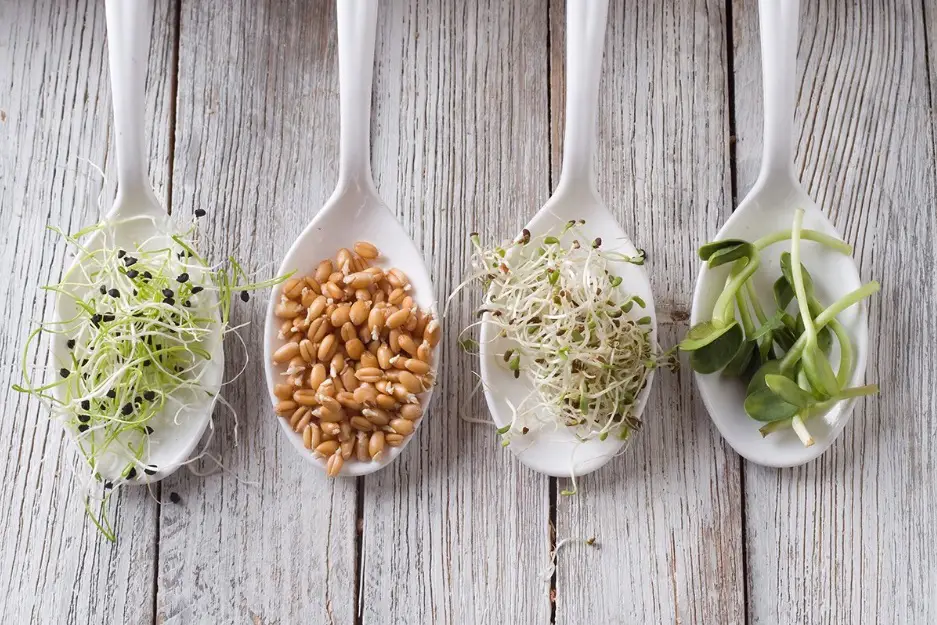
Conclusion
They are small leaves that develop from broccoli seeds and look like green mustard leaves, which are the latest delicacy.
They not only taste great, but they additionally are far healthier and contain more vitamins and minerals than their more mature counterparts.


